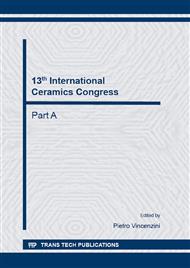p.113
p.118
p.126
p.132
p.139
p.145
p.151
p.157
p.162
Effect of Particle Size of ZrO2(Y2O3) Powders on the Shrinkage of the Sintered Substrate with Coloring Gradient
Abstract:
ZrO2(Y2O3)-based ceramics with coloring gradient can facilitate the development of dental prosthesis by the improvement of esthetic properties. In this work, ZrO2 powders with different particle sizes were investigated. White and yellow zirconia powders (TOSOH Corporation-Japan) were characterized by particles size distribution using nanoSight-LM20 analyzer. Furthermore, samples were characterized by X-Ray diffraction, Scanning Electron Microscopy and relative density. Compacts with two layers, one white and one yellow were uniaxially pressed at 80MPa and sintered at 1530°C-120min. The yellow-powder presented average particles size of 180±66nm, while the white-powder presented particles size of 198±73nm. After sintering, full dense ceramics with tetragonal phase were obtained. The linear shrinkage of the yellow and white-layer was 22.75% and 22.05% respectively. This difference in shrinkage is important in the machining of prostheses in ceramic CAD/CAM systems, because they lead to difficulties in adapting this customized prosthesis in patients.
Info:
Periodical:
Pages:
162-168
Citation:
Online since:
October 2014
Keywords:
Price:
Сopyright:
© 2014 Trans Tech Publications Ltd. All Rights Reserved
Share:
Citation:


